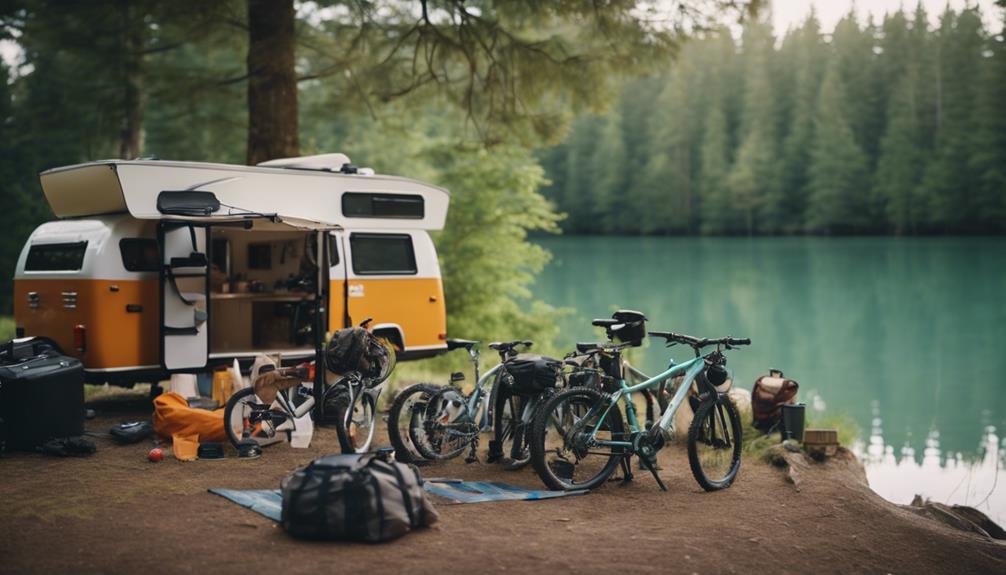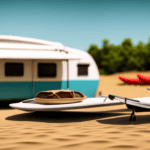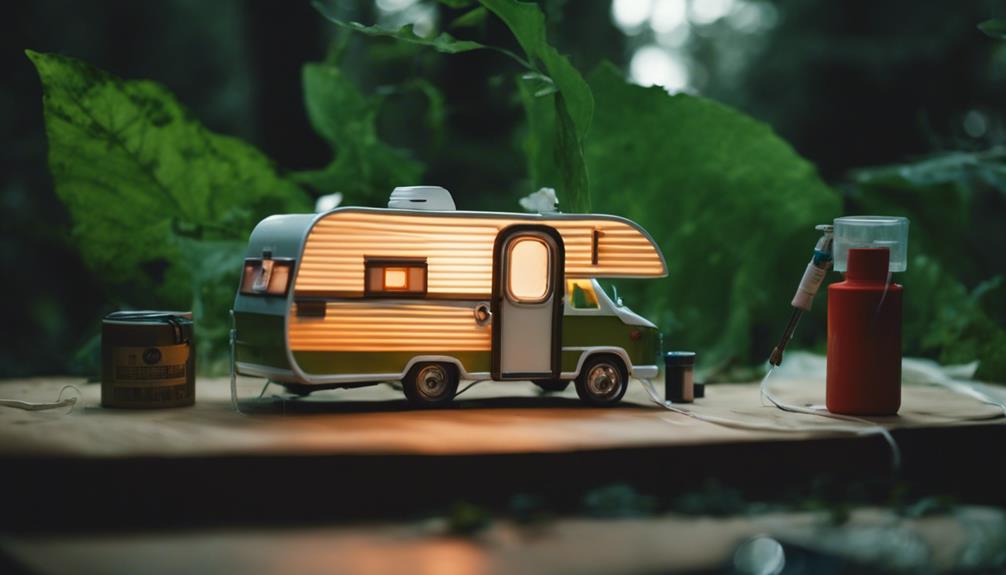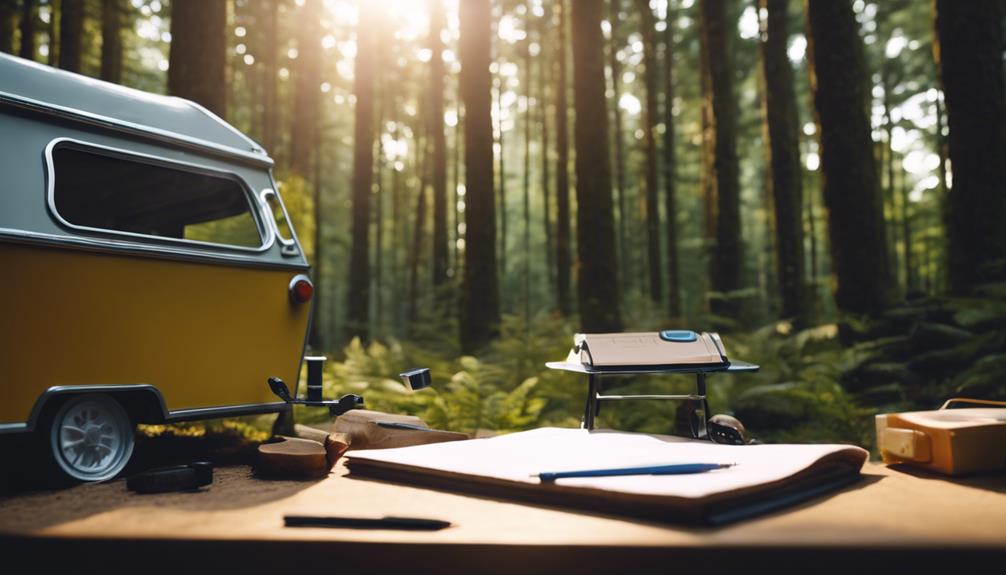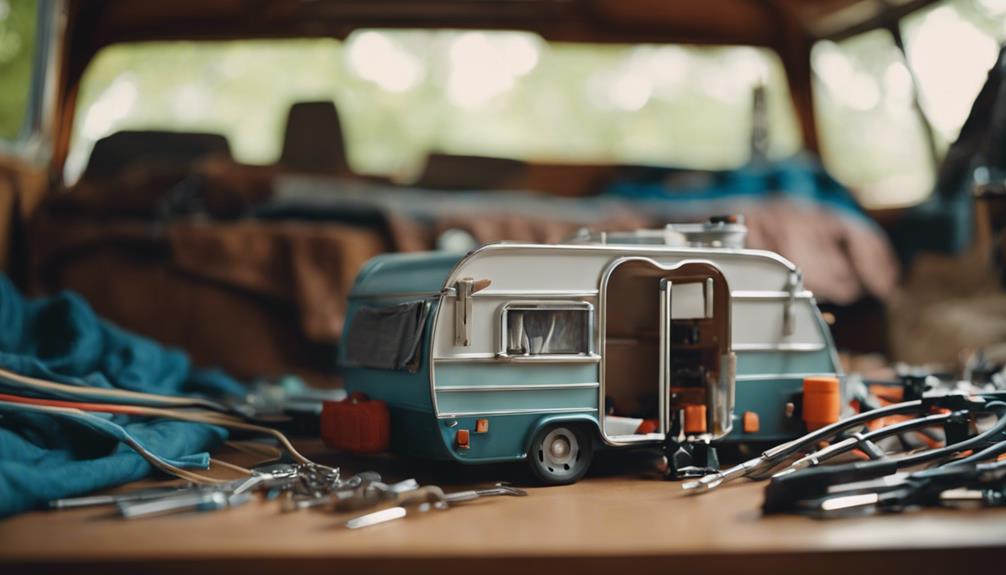To carry bikes with a pop-up camper, start by selecting the right bike rack. Hitch-mounted racks are a top choice for their stability and easy access. Confirm your rack can handle the weight and check the tongue weight for safe towing. Don't forget to use safety straps to minimize bike movement and keep everything secure. If you're feeling crafty, consider DIY solutions for custom carriers that suit your needs. Always inspect your hitch and racks before hitting the road. Stick around, and you'll uncover more tips for a hassle-free biking adventure with your camper.
Key Takeaways
- Choose a hitch-mounted rack for stability and easy access while ensuring it meets the tongue weight limits of your camper.
- Maintain proper weight distribution by keeping tongue weight at 10-15% of the total trailer weight to prevent swaying.
- Secure bikes with reliable safety straps and regular inspections to ensure minimal movement during transit.
- Check local towing regulations and understand your vehicle's weight capacity for safe travel.
Bike Rack Options
When it comes to carrying bikes with a pop-up camper, there are several bike rack options to contemplate for secure and hassle-free transport. A popular choice is the hitch-mounted rack, which offers stability while allowing you to transport bikes effectively. However, keep in mind that these racks can increase tongue weight, so you'll need to monitor weight distribution closely.
Roof racks, like the Swagman model 80550, are another solid option. They can secure up to four bikes, provided you install them correctly on your pop-up camper. This solution keeps your bikes up high and out of the way, but be sure to check compatibility first.
Bumper-mounted racks, such as the Swagman model 80500, can carry two bikes, but they may obstruct rear access and require a compatible bumper design.
If you're looking for something more personalized, consider DIY solutions. Custom bike carriers made from wood and eye bolts can provide a cost-effective and tailored way to transport bikes on your camper.
Ultimately, the right choice depends on your specific needs and preferences.
Safety Considerations
When you're loading bikes onto your pop-up camper, pay close attention to weight distribution.
Improperly balanced loads can cause swaying and instability on the road.
Make sure to secure your bikes properly to prevent any hazards while you travel.
Weight Distribution Importance
Proper weight distribution is vital for guaranteeing your pop-up camper tows safely and handles well, especially when carrying bikes. You should aim for a tongue weight of 10-15% of the total trailer weight to maintain stability. Centering your bikes over the wheels can help minimize negative tongue weight, reducing the risk of trailer sway. Excess weight at the rear can greatly affect camper handling, so regularly check your hitch integrity and load capacity.
If you have a soft suspension system, like in some minivans, heavy loads can cause sagging. Consider using airbags to counterbalance this effect. Additionally, make sure that your bike rack doesn't obstruct brake lights, as visibility is vital for safety. Always monitor your weight distribution during travel to comply with local towing regulations.
Taking these precautions helps maintain the overall safety of your trip. Remember, improper weight distribution can lead to dangerous situations, affecting your control over the pop-up camper and ultimately putting you and others at risk.
Prioritize proper loading techniques to guarantee a smooth and secure towing experience.
Securing Bikes Properly
Securing your bikes properly is vital to preventing damage and guaranteeing safety during transport. Start by choosing a reliable hitch mount rack or bike carrier that fits your camper. When securing bikes, use safety straps to stabilize them and minimize movement, which helps maintain stability during your journey.
It's essential to monitor the tongue weight; verify that the combined weight of the bikes doesn't exceed the rack's weight limits to avoid towing issues. Center the bikes over the carrier wheels for added balance, and check the attachment points frequently, especially on long trips. Regular maintenance of your bike racks and carriers can prevent wear and tear, ensuring everything remains secure and functional.
For enhanced safety, consider adding reflective tape to your bikes. This increases visibility during travel, particularly in low-light conditions, reducing the risk of accidents.
DIY Solutions
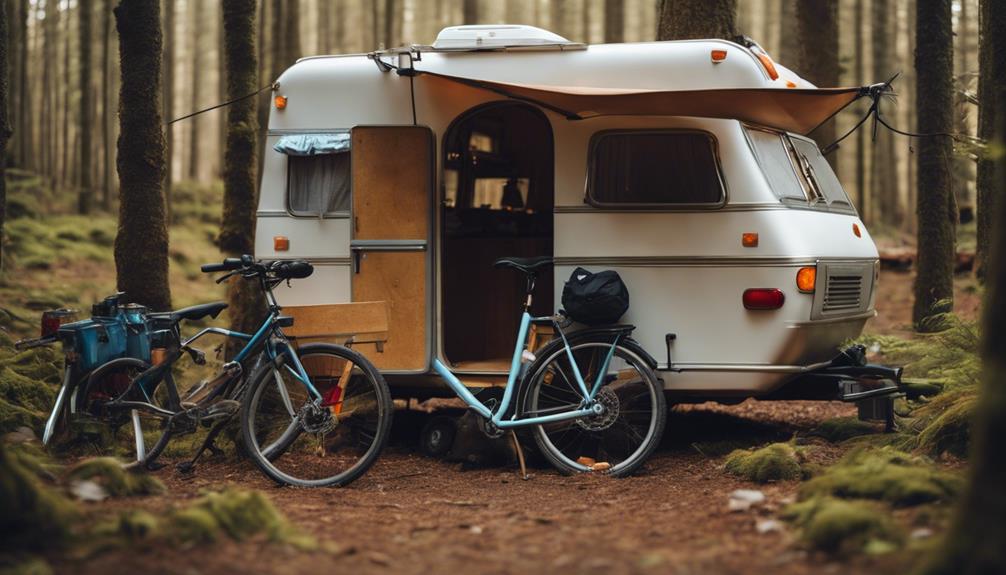
Creating a custom bike carrier for your pop-up camper can be an enjoyable and practical DIY project that enhances your outdoor adventures. With the right materials, you can build effective DIY bike carriers that fit your specific needs. Many pop-up campers have built-in load rails, which provide a secure mounting point for your custom creations.
One popular design involves using L-brackets and threaded rods to create a fork-mount bike rack. This setup allows for versatile bike storage solutions while keeping your bikes stable during transit. To further guarantee safety, consider using bungee cords to secure the bike wheels inside the camper, preventing movement that could lead to damage.
Don't hesitate to reach out to online community forums for inspiration and guidance. You'll find a wealth of bike rack designs and modifications shared by fellow outdoor enthusiasts. By engaging with others, you can refine your ideas and learn from their experiences, making your DIY project even more successful.
With a little creativity and effort, you'll have a reliable bike carrier that enhances your camping trips, letting you enjoy biking adventures wherever you roam.
User Recommendations
Many campers recommend hitch-mounted racks for their stability and ease of access, ensuring a smooth ride while transporting bikes. These racks, however, should never exceed the maximum tongue weight of your towing vehicle to maintain safety.
If you prefer a roof-mounted option, roof racks like the Yakima Frontloader are popular. They provide easy access to the camper's rear but require careful planning to prevent any damage to the roof.
For those looking to save money, DIY bike carriers are a great choice. Many users share their designs using materials such as wood and eye bolts, offering secure and removable solutions. Additionally, consider custom modifications like front-mounted hitches or double hitch ball setups, which help balance bike transport with towing capabilities.
Engaging with online forums can also yield valuable recommendations. Campers often share their experiences and tips, leading to innovative solutions that enhance bike transport while maintaining camper stability.
Community Engagement
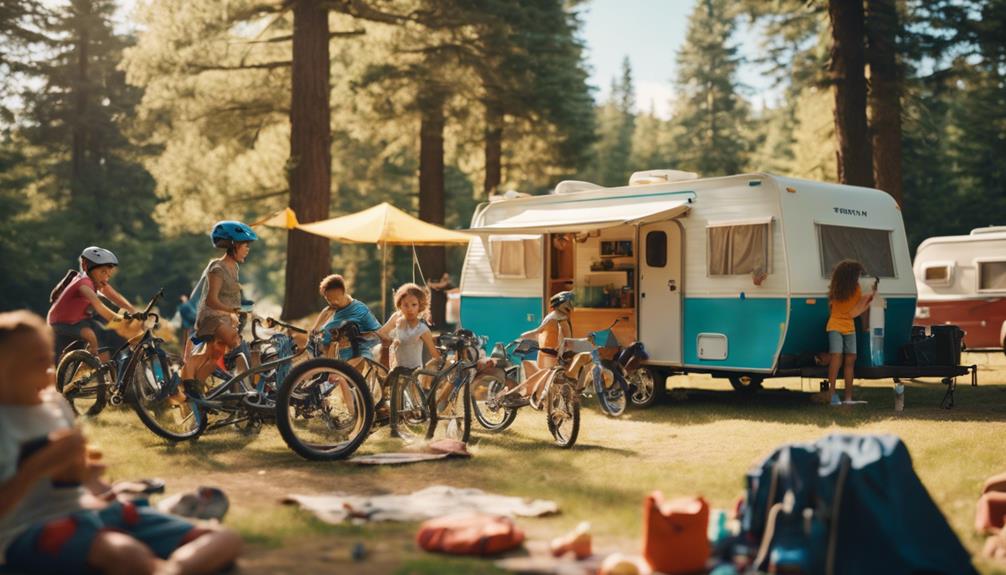
Engaging with online communities can greatly enhance your knowledge and skills for transporting bikes with pop-up campers. By tapping into these resources, you can gain valuable insights on effective bike transport methods, including the use of trailer hitches and roof racks. Community feedback is essential, as members often share personal experiences and solutions that can save you time and money.
Here are some key benefits of engaging with these communities:
- DIY Solutions: Discover custom bike racks made from common materials that are both cost-effective and functional.
- Stability Tips: Learn about hitch-mounted racks for better stability and how to secure your bikes to prevent damage during transit.
- Weight Distribution Insights: Understand the importance of weight distribution while towing to guarantee safe travel.
Equipment Requirements
When you're ready to hit the road with your bikes, it's essential to have the right equipment.
You'll need to choose the best bike rack type for your pop-up camper and guarantee you have all necessary safety gear.
Let's look at what you need for a secure and hassle-free transport experience.
Essential Bike Rack Types
Choosing the right bike rack type is essential for safely transporting your bikes with a pop-up camper. Each option has its advantages, so consider what fits your needs best.
- Hitch-mounted racks: These are stable and can handle a maximum tongue weight of around 350 lbs, but verify your tow vehicle or camper has a compatible hitch.
- Roof-mounted racks: Ideal for keeping the rear unobstructed, models like the Swagman 80550 can carry up to four bikes. Just be cautious during bike rack installation to avoid roof damage.
- Bumper-mounted racks: Designed for sturdy bumpers, options like the Swagman 80500 support two bikes and are great for compact setups.
Remember to use safety straps to secure your bikes effectively and conduct regular inspections of all attachment points. This will help maintain safety during your bike transportation adventures.
Choose the right rack type that verifies camper compatibility and fits your biking lifestyle!
Necessary Safety Equipment
Having the right safety equipment is essential for securely transporting your bikes with a pop-up camper. To guarantee a safe journey, consider incorporating the following items:
| Safety Equipment | Purpose | Maintenance Tips |
|---|---|---|
| Safety straps | Secure bikes firmly to the rack | Check for frays or wear |
| Locking anti-rattle hitch pin | Minimize movement during transit | Inspect for rust or damage |
| Wiring harness | Guarantee visibility with trailer lights | Verify connections regularly |
| Reflective tape | Increase visibility in low-light conditions | Replace when worn |
| Emergency tools | Quick fixes on the road | Keep a checklist for items |
| Tire repair kits | Handle flat tires | Inspect regularly |
| Bike maintenance tools | Perform basic repairs | Guarantee complete toolkit |
Regular maintenance checks on all bike rack components, such as bolts and straps, will enhance safety. Using reflective tape on your bikes improves visibility to other drivers, especially at night. By taking these precautions, you'll guarantee a safer and more enjoyable biking experience during your travels.
Towing Tips
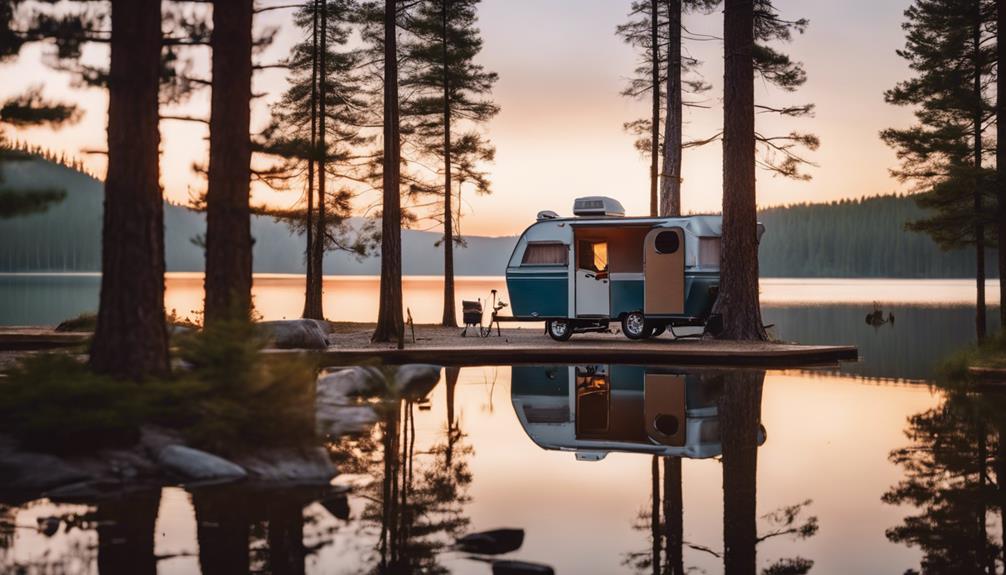
Verify your vehicle and hitch's weight capacity to guarantee safe towing, aiming for a maximum tongue weight of 75-150 lbs for lightweight campers. Following these towing tips will help guarantee a smooth journey while transporting your bikes.
Check tire pressure: Maintain proper tire pressure on both your vehicle and camper for ideal stability and handling.
Inspect connections: Regularly check all connections, including the hitch and safety straps, before hitting the road to avoid accidents.
Drive at reduced speeds: When towing, especially with added weight from cycle transport, lower your driving speed to enhance stability and control.
Understand local regulations: Familiarize yourself with local towing laws to guarantee compliance and safe travel.
Frequently Asked Questions
How Do You Transport Bikes With Camper Trailer?
You can transport bikes with a camper trailer using roof-mounted racks, hitch-mounted options, or bumper-mounted systems. Just guarantee proper weight distribution and safety compliance, so your journey remains stable and enjoyable.
What Is the Best Way to Carry Bikes on a Motorhome?
The best way to carry bikes on your motorhome is using a hitch-mounted rack. It provides stability and easy access. Guarantee proper weight distribution for safe towing and avoid any interference with brake lights.
What Is the Best Way to Carry a Bike on a Caravan?
Like a trusty steed, your bike deserves the best ride too. For carrying it on a caravan, consider hitch-mounted racks for stability or roof-mounted options for convenience, but always check weight limits and visibility.
What Is the Best Way to Carry a Bike?
To carry a bike effectively, consider using a hitch-mounted rack for stability and ease of use. Confirm it fits your vehicle and doesn't obstruct access. Alternatively, explore roof-mounted or bumper-mounted options for different needs.
What is the best way to pack bikes when using a pop-up camper for outdoor activities?
When preparing for outdoor activities with a pop-up camper, it’s essential to use efficient popup camper packing tips for bringing along bikes. Consider using bike racks or mounts on the camper to secure the bikes during travel. Additionally, disassembling the bikes and storing them in protective bags can save space and keep them safe.
Conclusion
Carrying bikes with your pop-up camper can open up a world of adventure, like revealing the door to a treasure chest of experiences.
By choosing the right rack and prioritizing safety, you're not just transporting bikes; you're paving the way for unforgettable memories.
Whether you opt for DIY solutions or rely on user recommendations, the road ahead promises excitement.
So gear up, hit the road, and let the journey unfold—your next great adventure is just a pedal away!

